Digital Marketing Report: GDPR, Challenges, Solutions, and Effects
VerifiedAdded on 2021/04/21
|12
|3100
|48
Report
AI Summary
This report delves into the multifaceted world of digital marketing, focusing on the implications of the General Data Protection Regulation (GDPR). It begins by outlining the core principles of GDPR and its importance in safeguarding customer data in the digital age. The report then identifies and analyzes key challenges in digital marketing, such as generating effective traffic and leads, measuring return on investment (ROI), managing websites, and understanding customer preferences. It also explores various solutions to these challenges, including producing high-quality content, optimizing website management through SEO, and leveraging marketing software. The report further examines the effect of GDPR implementation on digital marketing, highlighting the need for businesses to adapt to new regulations regarding data privacy and customer consent. The report concludes by emphasizing the importance of understanding customer preferences and building strong customer relationships in a competitive digital landscape, while adhering to GDPR compliance for a safer and more effective digital platform.

Running head: DIGITAL MARKETING
Digital Marketing
Name of the student
University name
Author’s note
Digital Marketing
Name of the student
University name
Author’s note
Paraphrase This Document
Need a fresh take? Get an instant paraphrase of this document with our AI Paraphraser

1
DIGITAL MARKETING
Table of Contents
Introduction................................................................................................................................2
GDPR in digital marketing.........................................................................................................2
Challenges in digital marketing.................................................................................................4
Addressing the issues in digital marketing.................................................................................6
Effect of implementation of GDPR in digital marketing...........................................................7
Conclusion..................................................................................................................................8
References..................................................................................................................................9
DIGITAL MARKETING
Table of Contents
Introduction................................................................................................................................2
GDPR in digital marketing.........................................................................................................2
Challenges in digital marketing.................................................................................................4
Addressing the issues in digital marketing.................................................................................6
Effect of implementation of GDPR in digital marketing...........................................................7
Conclusion..................................................................................................................................8
References..................................................................................................................................9
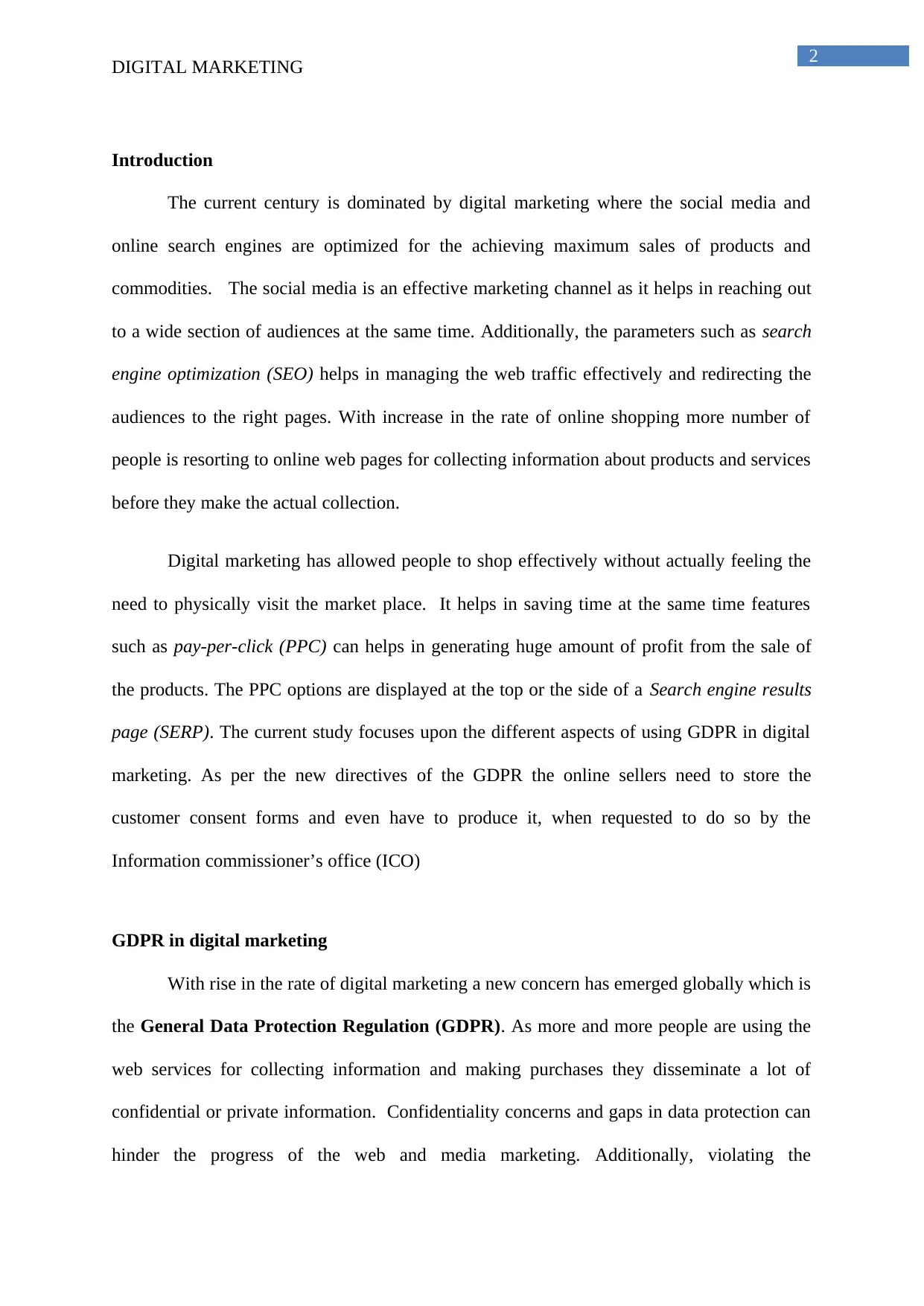
2
DIGITAL MARKETING
Introduction
The current century is dominated by digital marketing where the social media and
online search engines are optimized for the achieving maximum sales of products and
commodities. The social media is an effective marketing channel as it helps in reaching out
to a wide section of audiences at the same time. Additionally, the parameters such as search
engine optimization (SEO) helps in managing the web traffic effectively and redirecting the
audiences to the right pages. With increase in the rate of online shopping more number of
people is resorting to online web pages for collecting information about products and services
before they make the actual collection.
Digital marketing has allowed people to shop effectively without actually feeling the
need to physically visit the market place. It helps in saving time at the same time features
such as pay-per-click (PPC) can helps in generating huge amount of profit from the sale of
the products. The PPC options are displayed at the top or the side of a Search engine results
page (SERP). The current study focuses upon the different aspects of using GDPR in digital
marketing. As per the new directives of the GDPR the online sellers need to store the
customer consent forms and even have to produce it, when requested to do so by the
Information commissioner’s office (ICO)
GDPR in digital marketing
With rise in the rate of digital marketing a new concern has emerged globally which is
the General Data Protection Regulation (GDPR). As more and more people are using the
web services for collecting information and making purchases they disseminate a lot of
confidential or private information. Confidentiality concerns and gaps in data protection can
hinder the progress of the web and media marketing. Additionally, violating the
DIGITAL MARKETING
Introduction
The current century is dominated by digital marketing where the social media and
online search engines are optimized for the achieving maximum sales of products and
commodities. The social media is an effective marketing channel as it helps in reaching out
to a wide section of audiences at the same time. Additionally, the parameters such as search
engine optimization (SEO) helps in managing the web traffic effectively and redirecting the
audiences to the right pages. With increase in the rate of online shopping more number of
people is resorting to online web pages for collecting information about products and services
before they make the actual collection.
Digital marketing has allowed people to shop effectively without actually feeling the
need to physically visit the market place. It helps in saving time at the same time features
such as pay-per-click (PPC) can helps in generating huge amount of profit from the sale of
the products. The PPC options are displayed at the top or the side of a Search engine results
page (SERP). The current study focuses upon the different aspects of using GDPR in digital
marketing. As per the new directives of the GDPR the online sellers need to store the
customer consent forms and even have to produce it, when requested to do so by the
Information commissioner’s office (ICO)
GDPR in digital marketing
With rise in the rate of digital marketing a new concern has emerged globally which is
the General Data Protection Regulation (GDPR). As more and more people are using the
web services for collecting information and making purchases they disseminate a lot of
confidential or private information. Confidentiality concerns and gaps in data protection can
hinder the progress of the web and media marketing. Additionally, violating the
⊘ This is a preview!⊘
Do you want full access?
Subscribe today to unlock all pages.

Trusted by 1+ million students worldwide
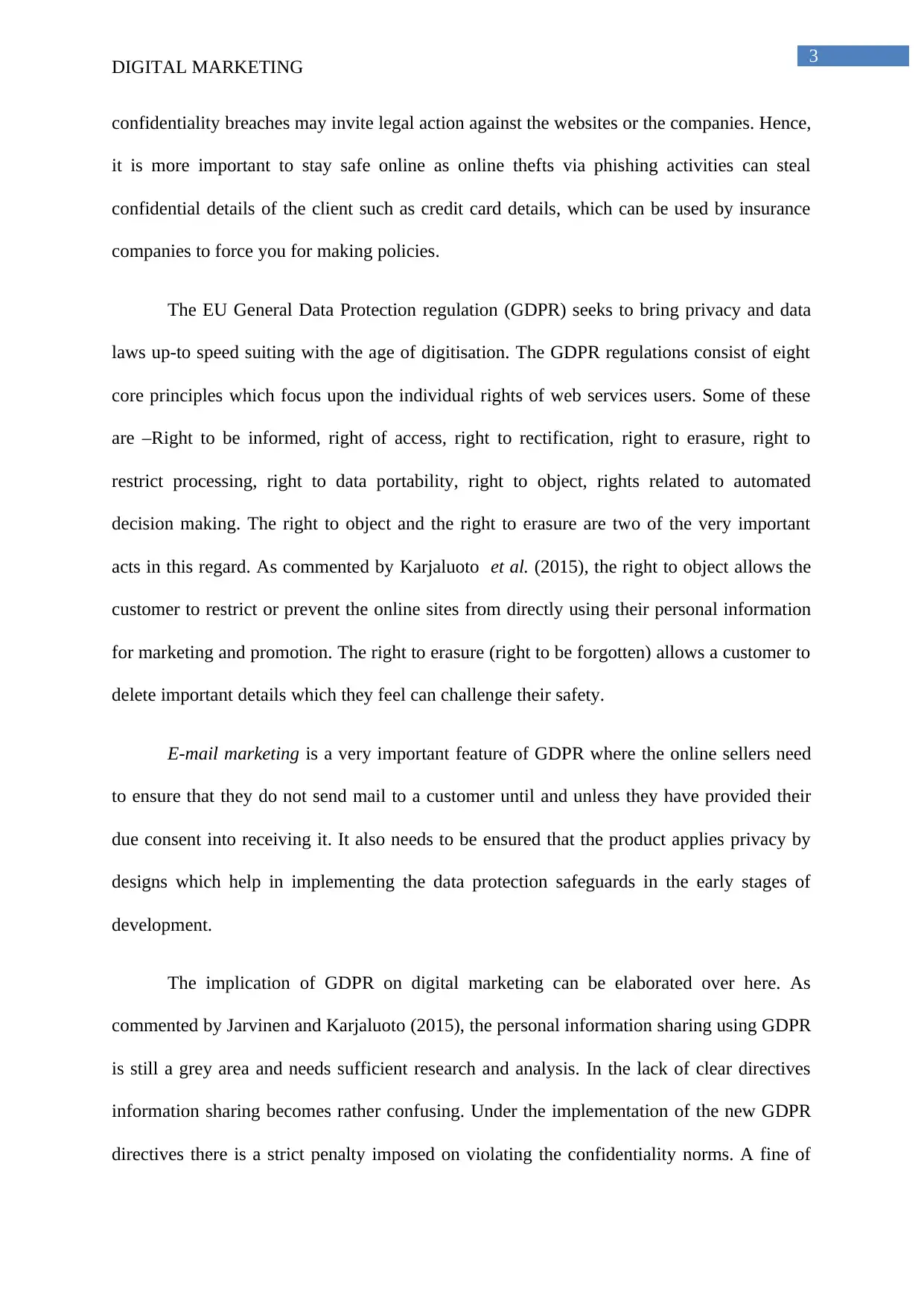
3
DIGITAL MARKETING
confidentiality breaches may invite legal action against the websites or the companies. Hence,
it is more important to stay safe online as online thefts via phishing activities can steal
confidential details of the client such as credit card details, which can be used by insurance
companies to force you for making policies.
The EU General Data Protection regulation (GDPR) seeks to bring privacy and data
laws up-to speed suiting with the age of digitisation. The GDPR regulations consist of eight
core principles which focus upon the individual rights of web services users. Some of these
are –Right to be informed, right of access, right to rectification, right to erasure, right to
restrict processing, right to data portability, right to object, rights related to automated
decision making. The right to object and the right to erasure are two of the very important
acts in this regard. As commented by Karjaluoto et al. (2015), the right to object allows the
customer to restrict or prevent the online sites from directly using their personal information
for marketing and promotion. The right to erasure (right to be forgotten) allows a customer to
delete important details which they feel can challenge their safety.
E-mail marketing is a very important feature of GDPR where the online sellers need
to ensure that they do not send mail to a customer until and unless they have provided their
due consent into receiving it. It also needs to be ensured that the product applies privacy by
designs which help in implementing the data protection safeguards in the early stages of
development.
The implication of GDPR on digital marketing can be elaborated over here. As
commented by Jarvinen and Karjaluoto (2015), the personal information sharing using GDPR
is still a grey area and needs sufficient research and analysis. In the lack of clear directives
information sharing becomes rather confusing. Under the implementation of the new GDPR
directives there is a strict penalty imposed on violating the confidentiality norms. A fine of
DIGITAL MARKETING
confidentiality breaches may invite legal action against the websites or the companies. Hence,
it is more important to stay safe online as online thefts via phishing activities can steal
confidential details of the client such as credit card details, which can be used by insurance
companies to force you for making policies.
The EU General Data Protection regulation (GDPR) seeks to bring privacy and data
laws up-to speed suiting with the age of digitisation. The GDPR regulations consist of eight
core principles which focus upon the individual rights of web services users. Some of these
are –Right to be informed, right of access, right to rectification, right to erasure, right to
restrict processing, right to data portability, right to object, rights related to automated
decision making. The right to object and the right to erasure are two of the very important
acts in this regard. As commented by Karjaluoto et al. (2015), the right to object allows the
customer to restrict or prevent the online sites from directly using their personal information
for marketing and promotion. The right to erasure (right to be forgotten) allows a customer to
delete important details which they feel can challenge their safety.
E-mail marketing is a very important feature of GDPR where the online sellers need
to ensure that they do not send mail to a customer until and unless they have provided their
due consent into receiving it. It also needs to be ensured that the product applies privacy by
designs which help in implementing the data protection safeguards in the early stages of
development.
The implication of GDPR on digital marketing can be elaborated over here. As
commented by Jarvinen and Karjaluoto (2015), the personal information sharing using GDPR
is still a grey area and needs sufficient research and analysis. In the lack of clear directives
information sharing becomes rather confusing. Under the implementation of the new GDPR
directives there is a strict penalty imposed on violating the confidentiality norms. A fine of
Paraphrase This Document
Need a fresh take? Get an instant paraphrase of this document with our AI Paraphraser
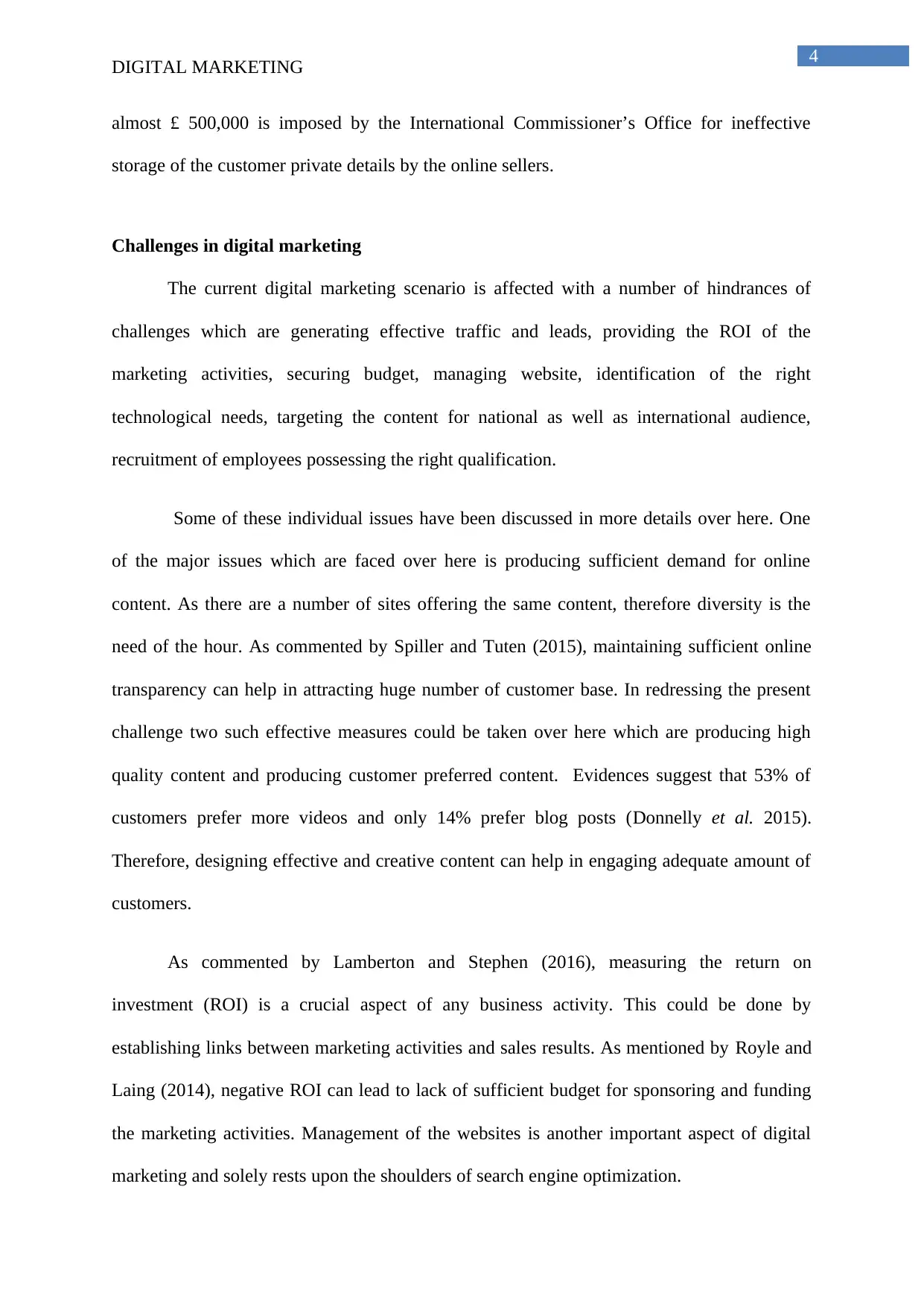
4
DIGITAL MARKETING
almost £ 500,000 is imposed by the International Commissioner’s Office for ineffective
storage of the customer private details by the online sellers.
Challenges in digital marketing
The current digital marketing scenario is affected with a number of hindrances of
challenges which are generating effective traffic and leads, providing the ROI of the
marketing activities, securing budget, managing website, identification of the right
technological needs, targeting the content for national as well as international audience,
recruitment of employees possessing the right qualification.
Some of these individual issues have been discussed in more details over here. One
of the major issues which are faced over here is producing sufficient demand for online
content. As there are a number of sites offering the same content, therefore diversity is the
need of the hour. As commented by Spiller and Tuten (2015), maintaining sufficient online
transparency can help in attracting huge number of customer base. In redressing the present
challenge two such effective measures could be taken over here which are producing high
quality content and producing customer preferred content. Evidences suggest that 53% of
customers prefer more videos and only 14% prefer blog posts (Donnelly et al. 2015).
Therefore, designing effective and creative content can help in engaging adequate amount of
customers.
As commented by Lamberton and Stephen (2016), measuring the return on
investment (ROI) is a crucial aspect of any business activity. This could be done by
establishing links between marketing activities and sales results. As mentioned by Royle and
Laing (2014), negative ROI can lead to lack of sufficient budget for sponsoring and funding
the marketing activities. Management of the websites is another important aspect of digital
marketing and solely rests upon the shoulders of search engine optimization.
DIGITAL MARKETING
almost £ 500,000 is imposed by the International Commissioner’s Office for ineffective
storage of the customer private details by the online sellers.
Challenges in digital marketing
The current digital marketing scenario is affected with a number of hindrances of
challenges which are generating effective traffic and leads, providing the ROI of the
marketing activities, securing budget, managing website, identification of the right
technological needs, targeting the content for national as well as international audience,
recruitment of employees possessing the right qualification.
Some of these individual issues have been discussed in more details over here. One
of the major issues which are faced over here is producing sufficient demand for online
content. As there are a number of sites offering the same content, therefore diversity is the
need of the hour. As commented by Spiller and Tuten (2015), maintaining sufficient online
transparency can help in attracting huge number of customer base. In redressing the present
challenge two such effective measures could be taken over here which are producing high
quality content and producing customer preferred content. Evidences suggest that 53% of
customers prefer more videos and only 14% prefer blog posts (Donnelly et al. 2015).
Therefore, designing effective and creative content can help in engaging adequate amount of
customers.
As commented by Lamberton and Stephen (2016), measuring the return on
investment (ROI) is a crucial aspect of any business activity. This could be done by
establishing links between marketing activities and sales results. As mentioned by Royle and
Laing (2014), negative ROI can lead to lack of sufficient budget for sponsoring and funding
the marketing activities. Management of the websites is another important aspect of digital
marketing and solely rests upon the shoulders of search engine optimization.

5
DIGITAL MARKETING
In this respect, a number of issues are faced in the effective implementation of Search
engine optimization. Some of these are ad frauds, difficulty in data collection, lacking
awareness regarding the use of marketing software, insufficient open platforms. Evidences
have suggested that United States have one of the worst ad fraud rates in the world which
rates in the world (Royle and Laing 2016). Therefore, superfluous advertising and lack of
transparency often results in negative revenue generation rather than upsetting the target
customers. As commented by Leeflang et al. (2014), lacking knowledge regarding data
collection at the functional and the operational level often leads to inappropriate web
trafficking. The insufficient number of online hits generated often results in losing the target
customer base. As reported by Holliman and Rowley (2014), more than 40% of the marketers
cannot draw insights from the data harvested. For the successful implementation of the search
engine optimization, integrated marketing strategies are required. An integrated platform
needs to be created using programmatic platforms and automation marketing services.
Identification of the right technologies is important for effective social media marketing. The
lack of expertise within the particular industry can affect the sales of the products and
services. Additionally, identification of the right target customer is crucial to achieving
maximum sales of the products and services. In this respect, the marketers often face issues in
identifying the global customer preferences. As commented by Patti et al. (2017), the
personas of the buyers needs to be identified as part of the marketing plan and gimmick. The
marketers all over the world are using online surveys as an effective tool for understanding
individual customer preferences. Some of these are pasted as links in the whatsapp of
facebook pages, which consists of certain random questions. Based upon the responses from
the customers, the webpages are further designed and promoted. Another important feature is
hiring and recruitment of the right candidate who can work as professional web content
developers.
DIGITAL MARKETING
In this respect, a number of issues are faced in the effective implementation of Search
engine optimization. Some of these are ad frauds, difficulty in data collection, lacking
awareness regarding the use of marketing software, insufficient open platforms. Evidences
have suggested that United States have one of the worst ad fraud rates in the world which
rates in the world (Royle and Laing 2016). Therefore, superfluous advertising and lack of
transparency often results in negative revenue generation rather than upsetting the target
customers. As commented by Leeflang et al. (2014), lacking knowledge regarding data
collection at the functional and the operational level often leads to inappropriate web
trafficking. The insufficient number of online hits generated often results in losing the target
customer base. As reported by Holliman and Rowley (2014), more than 40% of the marketers
cannot draw insights from the data harvested. For the successful implementation of the search
engine optimization, integrated marketing strategies are required. An integrated platform
needs to be created using programmatic platforms and automation marketing services.
Identification of the right technologies is important for effective social media marketing. The
lack of expertise within the particular industry can affect the sales of the products and
services. Additionally, identification of the right target customer is crucial to achieving
maximum sales of the products and services. In this respect, the marketers often face issues in
identifying the global customer preferences. As commented by Patti et al. (2017), the
personas of the buyers needs to be identified as part of the marketing plan and gimmick. The
marketers all over the world are using online surveys as an effective tool for understanding
individual customer preferences. Some of these are pasted as links in the whatsapp of
facebook pages, which consists of certain random questions. Based upon the responses from
the customers, the webpages are further designed and promoted. Another important feature is
hiring and recruitment of the right candidate who can work as professional web content
developers.
⊘ This is a preview!⊘
Do you want full access?
Subscribe today to unlock all pages.

Trusted by 1+ million students worldwide

6
DIGITAL MARKETING
Addressing the issues in digital marketing
The issues faced in digital marketing could be addressed in a number of ways, which
have been discussed in more details over here. Some of these are garnering high rates of
return on investment. As mentioned by Habibi et al. (2015), high rates of ROI could be
guaranteed on designing of an effective webpage. Therefore, recruitment of individual with
knowledge in the areas of website designing and SEO can help in generating effective web
content which can attract a large size customer base. As commented by Keegan and Rowley
(2017), a positive ROI helps in securing sufficient amount of budget for future planning and
designing of promotional campaigns. The web trafficking can also be used positively for
gathering large number of customer base by multiple sites integration (Mitchell 2016). For
example linking of instagram with facebook can help is one such example where the contents
promoted over facebook are redirected towards instagram in the form of pictures and posts.
Some of these help in the development of sufficient customer awareness. It has been seen that
most of the present day marketers are unable to use some of the marketing software which
helps in catching the attention of diverse group of customers. Some of the marketing software
which could be mentioned over here in this regard is –Marketo, hubspot, Yesware etc. In
order to evolve from the tradition marketing strategies it is necessary to effectively use
website designing and blogging. The basic of the search engine optimization is putting
enough importance on the keyword. The customers have been seen to use some keywords
more often than others. Therefore, developing engaging content around those keywords can
help in attracting large number of customers. Additionally, compliance monitoring with the
pay per click services can help in development of loyal customer base (Montgomery and
Chester 2015).
DIGITAL MARKETING
Addressing the issues in digital marketing
The issues faced in digital marketing could be addressed in a number of ways, which
have been discussed in more details over here. Some of these are garnering high rates of
return on investment. As mentioned by Habibi et al. (2015), high rates of ROI could be
guaranteed on designing of an effective webpage. Therefore, recruitment of individual with
knowledge in the areas of website designing and SEO can help in generating effective web
content which can attract a large size customer base. As commented by Keegan and Rowley
(2017), a positive ROI helps in securing sufficient amount of budget for future planning and
designing of promotional campaigns. The web trafficking can also be used positively for
gathering large number of customer base by multiple sites integration (Mitchell 2016). For
example linking of instagram with facebook can help is one such example where the contents
promoted over facebook are redirected towards instagram in the form of pictures and posts.
Some of these help in the development of sufficient customer awareness. It has been seen that
most of the present day marketers are unable to use some of the marketing software which
helps in catching the attention of diverse group of customers. Some of the marketing software
which could be mentioned over here in this regard is –Marketo, hubspot, Yesware etc. In
order to evolve from the tradition marketing strategies it is necessary to effectively use
website designing and blogging. The basic of the search engine optimization is putting
enough importance on the keyword. The customers have been seen to use some keywords
more often than others. Therefore, developing engaging content around those keywords can
help in attracting large number of customers. Additionally, compliance monitoring with the
pay per click services can help in development of loyal customer base (Montgomery and
Chester 2015).
Paraphrase This Document
Need a fresh take? Get an instant paraphrase of this document with our AI Paraphraser
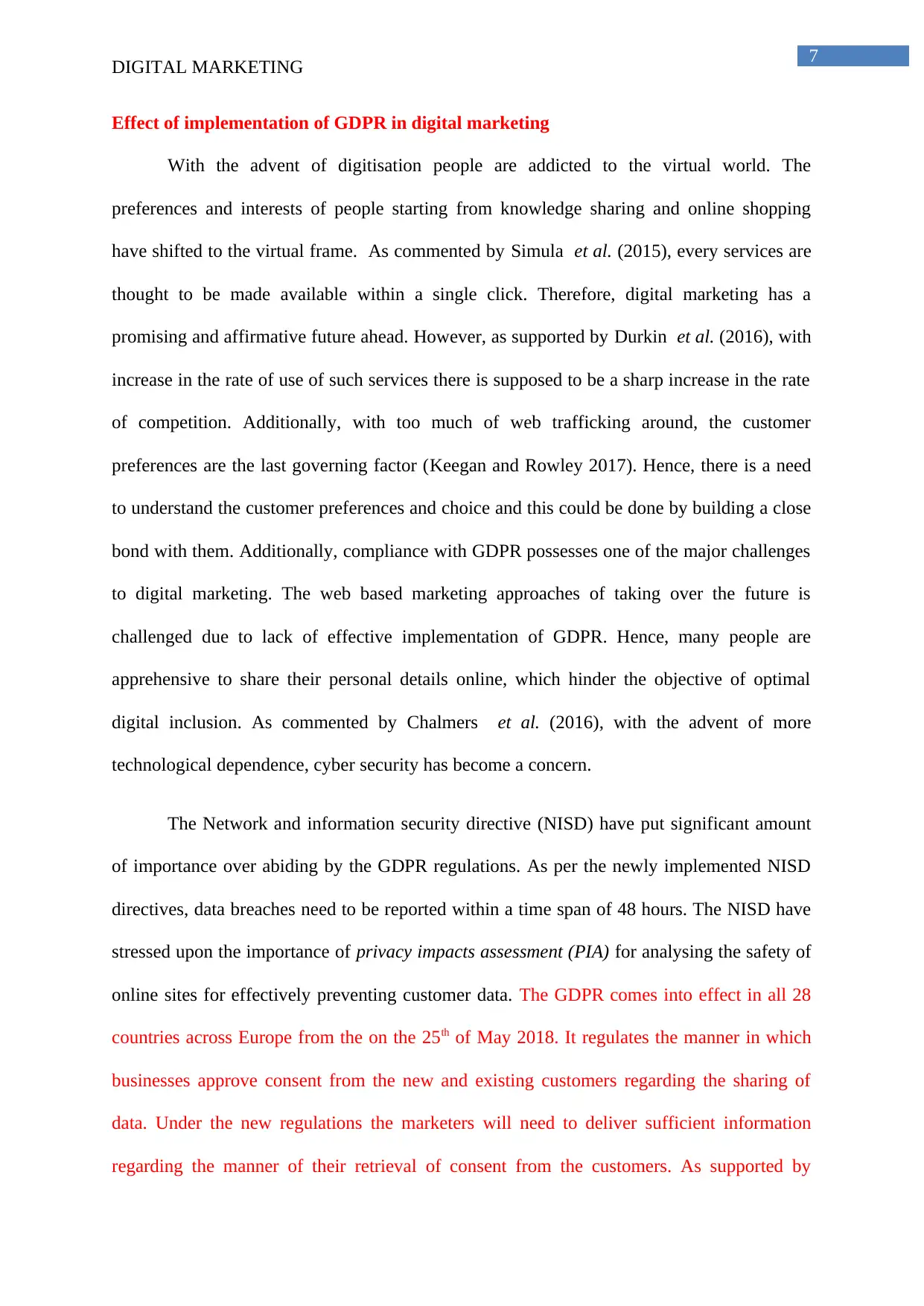
7
DIGITAL MARKETING
Effect of implementation of GDPR in digital marketing
With the advent of digitisation people are addicted to the virtual world. The
preferences and interests of people starting from knowledge sharing and online shopping
have shifted to the virtual frame. As commented by Simula et al. (2015), every services are
thought to be made available within a single click. Therefore, digital marketing has a
promising and affirmative future ahead. However, as supported by Durkin et al. (2016), with
increase in the rate of use of such services there is supposed to be a sharp increase in the rate
of competition. Additionally, with too much of web trafficking around, the customer
preferences are the last governing factor (Keegan and Rowley 2017). Hence, there is a need
to understand the customer preferences and choice and this could be done by building a close
bond with them. Additionally, compliance with GDPR possesses one of the major challenges
to digital marketing. The web based marketing approaches of taking over the future is
challenged due to lack of effective implementation of GDPR. Hence, many people are
apprehensive to share their personal details online, which hinder the objective of optimal
digital inclusion. As commented by Chalmers et al. (2016), with the advent of more
technological dependence, cyber security has become a concern.
The Network and information security directive (NISD) have put significant amount
of importance over abiding by the GDPR regulations. As per the newly implemented NISD
directives, data breaches need to be reported within a time span of 48 hours. The NISD have
stressed upon the importance of privacy impacts assessment (PIA) for analysing the safety of
online sites for effectively preventing customer data. The GDPR comes into effect in all 28
countries across Europe from the on the 25th of May 2018. It regulates the manner in which
businesses approve consent from the new and existing customers regarding the sharing of
data. Under the new regulations the marketers will need to deliver sufficient information
regarding the manner of their retrieval of consent from the customers. As supported by
DIGITAL MARKETING
Effect of implementation of GDPR in digital marketing
With the advent of digitisation people are addicted to the virtual world. The
preferences and interests of people starting from knowledge sharing and online shopping
have shifted to the virtual frame. As commented by Simula et al. (2015), every services are
thought to be made available within a single click. Therefore, digital marketing has a
promising and affirmative future ahead. However, as supported by Durkin et al. (2016), with
increase in the rate of use of such services there is supposed to be a sharp increase in the rate
of competition. Additionally, with too much of web trafficking around, the customer
preferences are the last governing factor (Keegan and Rowley 2017). Hence, there is a need
to understand the customer preferences and choice and this could be done by building a close
bond with them. Additionally, compliance with GDPR possesses one of the major challenges
to digital marketing. The web based marketing approaches of taking over the future is
challenged due to lack of effective implementation of GDPR. Hence, many people are
apprehensive to share their personal details online, which hinder the objective of optimal
digital inclusion. As commented by Chalmers et al. (2016), with the advent of more
technological dependence, cyber security has become a concern.
The Network and information security directive (NISD) have put significant amount
of importance over abiding by the GDPR regulations. As per the newly implemented NISD
directives, data breaches need to be reported within a time span of 48 hours. The NISD have
stressed upon the importance of privacy impacts assessment (PIA) for analysing the safety of
online sites for effectively preventing customer data. The GDPR comes into effect in all 28
countries across Europe from the on the 25th of May 2018. It regulates the manner in which
businesses approve consent from the new and existing customers regarding the sharing of
data. Under the new regulations the marketers will need to deliver sufficient information
regarding the manner of their retrieval of consent from the customers. As supported by
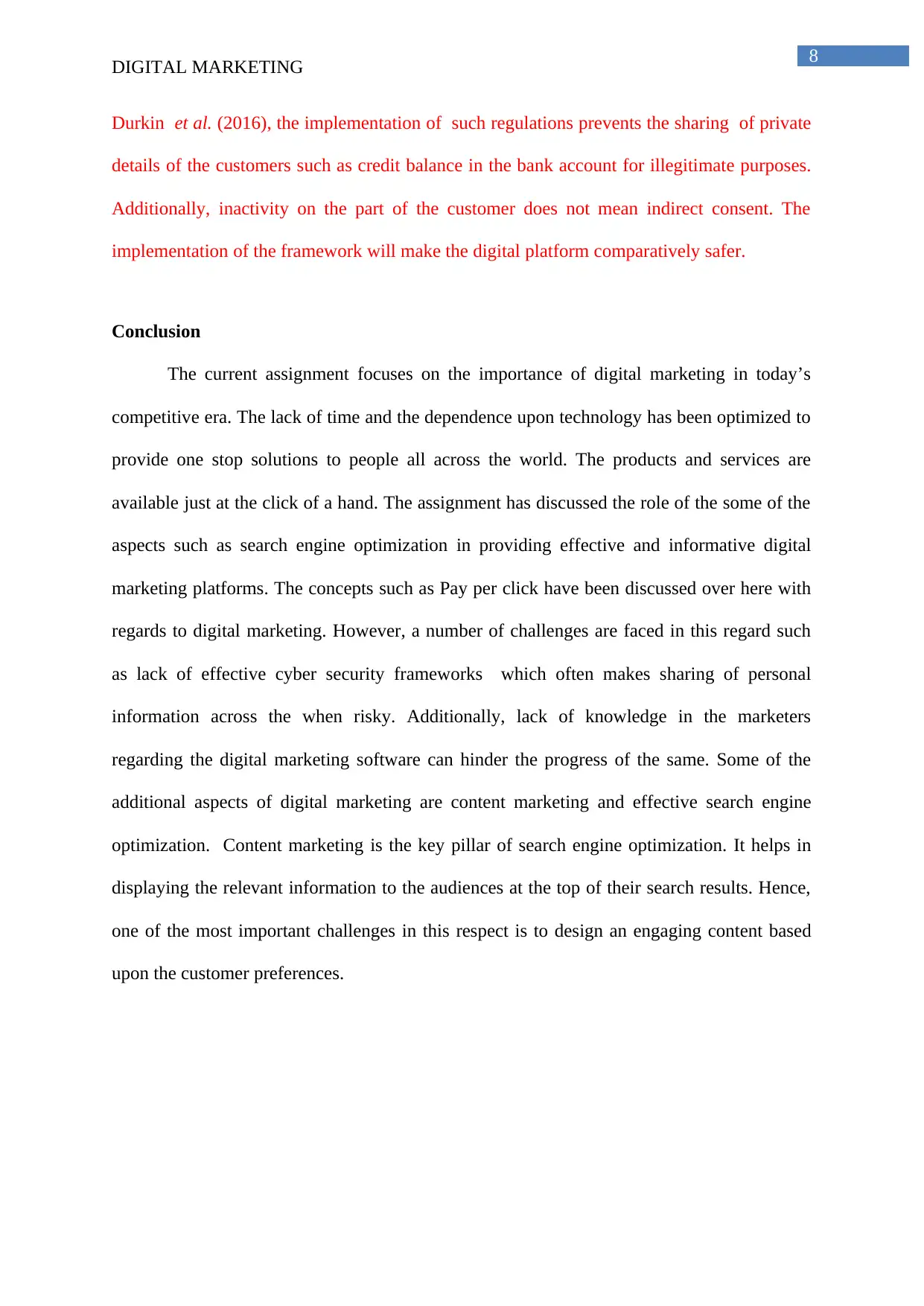
8
DIGITAL MARKETING
Durkin et al. (2016), the implementation of such regulations prevents the sharing of private
details of the customers such as credit balance in the bank account for illegitimate purposes.
Additionally, inactivity on the part of the customer does not mean indirect consent. The
implementation of the framework will make the digital platform comparatively safer.
Conclusion
The current assignment focuses on the importance of digital marketing in today’s
competitive era. The lack of time and the dependence upon technology has been optimized to
provide one stop solutions to people all across the world. The products and services are
available just at the click of a hand. The assignment has discussed the role of the some of the
aspects such as search engine optimization in providing effective and informative digital
marketing platforms. The concepts such as Pay per click have been discussed over here with
regards to digital marketing. However, a number of challenges are faced in this regard such
as lack of effective cyber security frameworks which often makes sharing of personal
information across the when risky. Additionally, lack of knowledge in the marketers
regarding the digital marketing software can hinder the progress of the same. Some of the
additional aspects of digital marketing are content marketing and effective search engine
optimization. Content marketing is the key pillar of search engine optimization. It helps in
displaying the relevant information to the audiences at the top of their search results. Hence,
one of the most important challenges in this respect is to design an engaging content based
upon the customer preferences.
DIGITAL MARKETING
Durkin et al. (2016), the implementation of such regulations prevents the sharing of private
details of the customers such as credit balance in the bank account for illegitimate purposes.
Additionally, inactivity on the part of the customer does not mean indirect consent. The
implementation of the framework will make the digital platform comparatively safer.
Conclusion
The current assignment focuses on the importance of digital marketing in today’s
competitive era. The lack of time and the dependence upon technology has been optimized to
provide one stop solutions to people all across the world. The products and services are
available just at the click of a hand. The assignment has discussed the role of the some of the
aspects such as search engine optimization in providing effective and informative digital
marketing platforms. The concepts such as Pay per click have been discussed over here with
regards to digital marketing. However, a number of challenges are faced in this regard such
as lack of effective cyber security frameworks which often makes sharing of personal
information across the when risky. Additionally, lack of knowledge in the marketers
regarding the digital marketing software can hinder the progress of the same. Some of the
additional aspects of digital marketing are content marketing and effective search engine
optimization. Content marketing is the key pillar of search engine optimization. It helps in
displaying the relevant information to the audiences at the top of their search results. Hence,
one of the most important challenges in this respect is to design an engaging content based
upon the customer preferences.
⊘ This is a preview!⊘
Do you want full access?
Subscribe today to unlock all pages.

Trusted by 1+ million students worldwide
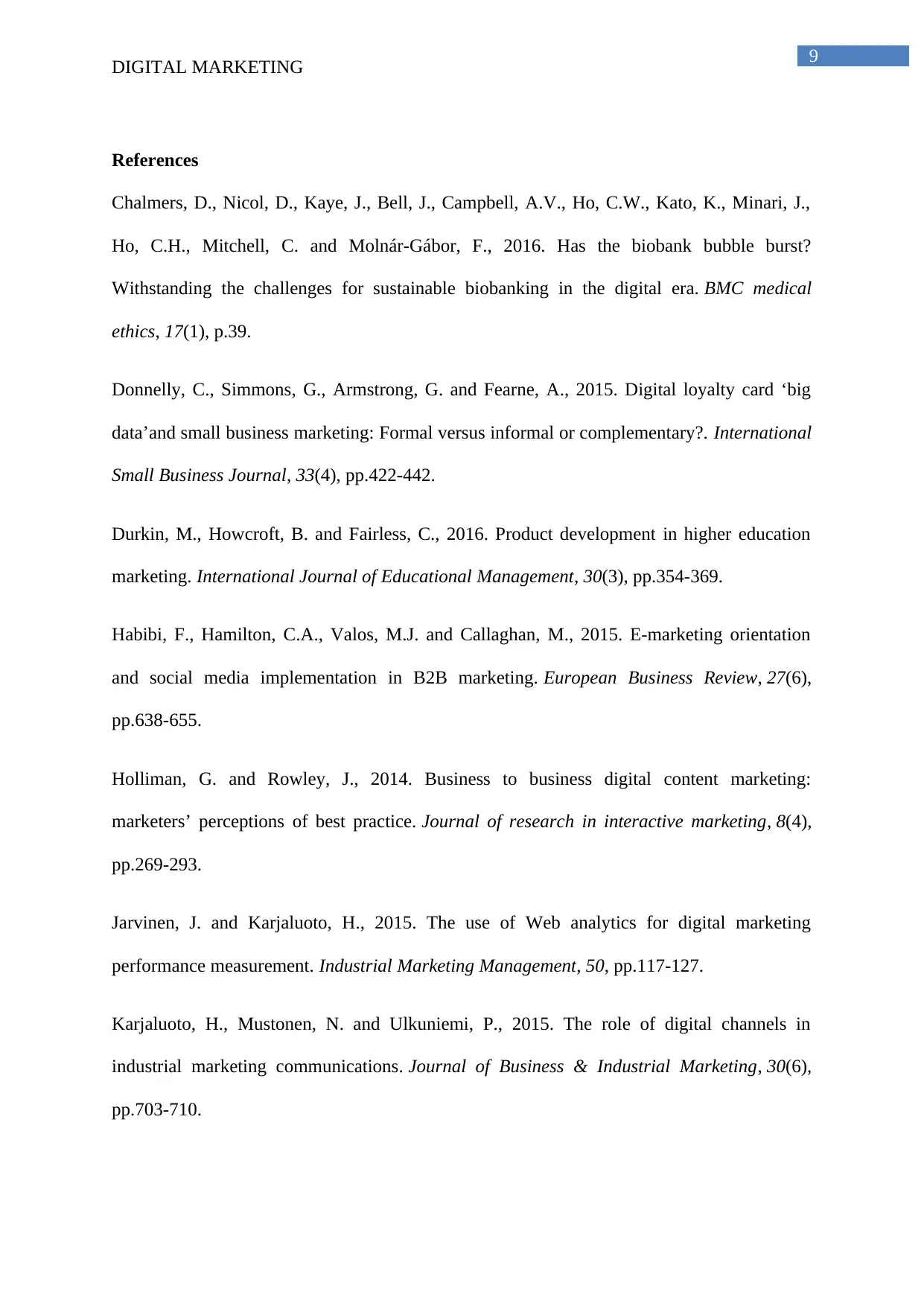
9
DIGITAL MARKETING
References
Chalmers, D., Nicol, D., Kaye, J., Bell, J., Campbell, A.V., Ho, C.W., Kato, K., Minari, J.,
Ho, C.H., Mitchell, C. and Molnár-Gábor, F., 2016. Has the biobank bubble burst?
Withstanding the challenges for sustainable biobanking in the digital era. BMC medical
ethics, 17(1), p.39.
Donnelly, C., Simmons, G., Armstrong, G. and Fearne, A., 2015. Digital loyalty card ‘big
data’and small business marketing: Formal versus informal or complementary?. International
Small Business Journal, 33(4), pp.422-442.
Durkin, M., Howcroft, B. and Fairless, C., 2016. Product development in higher education
marketing. International Journal of Educational Management, 30(3), pp.354-369.
Habibi, F., Hamilton, C.A., Valos, M.J. and Callaghan, M., 2015. E-marketing orientation
and social media implementation in B2B marketing. European Business Review, 27(6),
pp.638-655.
Holliman, G. and Rowley, J., 2014. Business to business digital content marketing:
marketers’ perceptions of best practice. Journal of research in interactive marketing, 8(4),
pp.269-293.
Jarvinen, J. and Karjaluoto, H., 2015. The use of Web analytics for digital marketing
performance measurement. Industrial Marketing Management, 50, pp.117-127.
Karjaluoto, H., Mustonen, N. and Ulkuniemi, P., 2015. The role of digital channels in
industrial marketing communications. Journal of Business & Industrial Marketing, 30(6),
pp.703-710.
DIGITAL MARKETING
References
Chalmers, D., Nicol, D., Kaye, J., Bell, J., Campbell, A.V., Ho, C.W., Kato, K., Minari, J.,
Ho, C.H., Mitchell, C. and Molnár-Gábor, F., 2016. Has the biobank bubble burst?
Withstanding the challenges for sustainable biobanking in the digital era. BMC medical
ethics, 17(1), p.39.
Donnelly, C., Simmons, G., Armstrong, G. and Fearne, A., 2015. Digital loyalty card ‘big
data’and small business marketing: Formal versus informal or complementary?. International
Small Business Journal, 33(4), pp.422-442.
Durkin, M., Howcroft, B. and Fairless, C., 2016. Product development in higher education
marketing. International Journal of Educational Management, 30(3), pp.354-369.
Habibi, F., Hamilton, C.A., Valos, M.J. and Callaghan, M., 2015. E-marketing orientation
and social media implementation in B2B marketing. European Business Review, 27(6),
pp.638-655.
Holliman, G. and Rowley, J., 2014. Business to business digital content marketing:
marketers’ perceptions of best practice. Journal of research in interactive marketing, 8(4),
pp.269-293.
Jarvinen, J. and Karjaluoto, H., 2015. The use of Web analytics for digital marketing
performance measurement. Industrial Marketing Management, 50, pp.117-127.
Karjaluoto, H., Mustonen, N. and Ulkuniemi, P., 2015. The role of digital channels in
industrial marketing communications. Journal of Business & Industrial Marketing, 30(6),
pp.703-710.
Paraphrase This Document
Need a fresh take? Get an instant paraphrase of this document with our AI Paraphraser
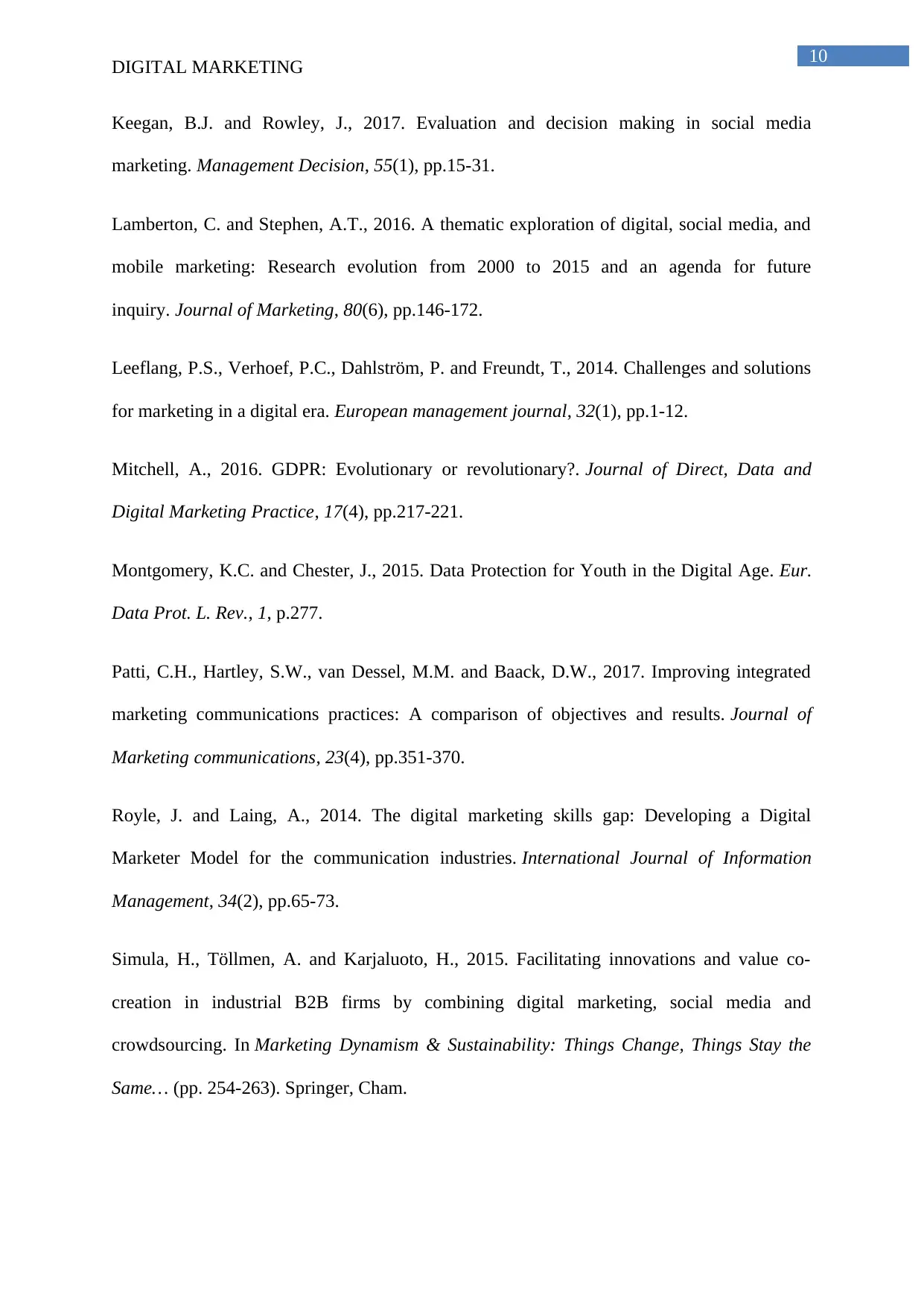
10
DIGITAL MARKETING
Keegan, B.J. and Rowley, J., 2017. Evaluation and decision making in social media
marketing. Management Decision, 55(1), pp.15-31.
Lamberton, C. and Stephen, A.T., 2016. A thematic exploration of digital, social media, and
mobile marketing: Research evolution from 2000 to 2015 and an agenda for future
inquiry. Journal of Marketing, 80(6), pp.146-172.
Leeflang, P.S., Verhoef, P.C., Dahlström, P. and Freundt, T., 2014. Challenges and solutions
for marketing in a digital era. European management journal, 32(1), pp.1-12.
Mitchell, A., 2016. GDPR: Evolutionary or revolutionary?. Journal of Direct, Data and
Digital Marketing Practice, 17(4), pp.217-221.
Montgomery, K.C. and Chester, J., 2015. Data Protection for Youth in the Digital Age. Eur.
Data Prot. L. Rev., 1, p.277.
Patti, C.H., Hartley, S.W., van Dessel, M.M. and Baack, D.W., 2017. Improving integrated
marketing communications practices: A comparison of objectives and results. Journal of
Marketing communications, 23(4), pp.351-370.
Royle, J. and Laing, A., 2014. The digital marketing skills gap: Developing a Digital
Marketer Model for the communication industries. International Journal of Information
Management, 34(2), pp.65-73.
Simula, H., Töllmen, A. and Karjaluoto, H., 2015. Facilitating innovations and value co-
creation in industrial B2B firms by combining digital marketing, social media and
crowdsourcing. In Marketing Dynamism & Sustainability: Things Change, Things Stay the
Same… (pp. 254-263). Springer, Cham.
DIGITAL MARKETING
Keegan, B.J. and Rowley, J., 2017. Evaluation and decision making in social media
marketing. Management Decision, 55(1), pp.15-31.
Lamberton, C. and Stephen, A.T., 2016. A thematic exploration of digital, social media, and
mobile marketing: Research evolution from 2000 to 2015 and an agenda for future
inquiry. Journal of Marketing, 80(6), pp.146-172.
Leeflang, P.S., Verhoef, P.C., Dahlström, P. and Freundt, T., 2014. Challenges and solutions
for marketing in a digital era. European management journal, 32(1), pp.1-12.
Mitchell, A., 2016. GDPR: Evolutionary or revolutionary?. Journal of Direct, Data and
Digital Marketing Practice, 17(4), pp.217-221.
Montgomery, K.C. and Chester, J., 2015. Data Protection for Youth in the Digital Age. Eur.
Data Prot. L. Rev., 1, p.277.
Patti, C.H., Hartley, S.W., van Dessel, M.M. and Baack, D.W., 2017. Improving integrated
marketing communications practices: A comparison of objectives and results. Journal of
Marketing communications, 23(4), pp.351-370.
Royle, J. and Laing, A., 2014. The digital marketing skills gap: Developing a Digital
Marketer Model for the communication industries. International Journal of Information
Management, 34(2), pp.65-73.
Simula, H., Töllmen, A. and Karjaluoto, H., 2015. Facilitating innovations and value co-
creation in industrial B2B firms by combining digital marketing, social media and
crowdsourcing. In Marketing Dynamism & Sustainability: Things Change, Things Stay the
Same… (pp. 254-263). Springer, Cham.

11
DIGITAL MARKETING
Spiller, L. and Tuten, T., 2015. Integrating metrics across the marketing curriculum: The
digital and social media opportunity. Journal of Marketing Education, 37(2), pp.114-126.
DIGITAL MARKETING
Spiller, L. and Tuten, T., 2015. Integrating metrics across the marketing curriculum: The
digital and social media opportunity. Journal of Marketing Education, 37(2), pp.114-126.
⊘ This is a preview!⊘
Do you want full access?
Subscribe today to unlock all pages.

Trusted by 1+ million students worldwide
1 out of 12
Related Documents
Your All-in-One AI-Powered Toolkit for Academic Success.
+13062052269
info@desklib.com
Available 24*7 on WhatsApp / Email
![[object Object]](/_next/static/media/star-bottom.7253800d.svg)
Unlock your academic potential
Copyright © 2020–2025 A2Z Services. All Rights Reserved. Developed and managed by ZUCOL.




